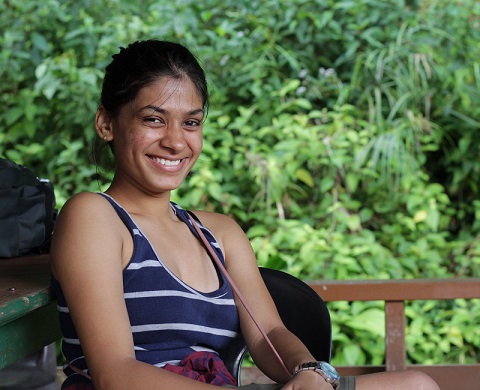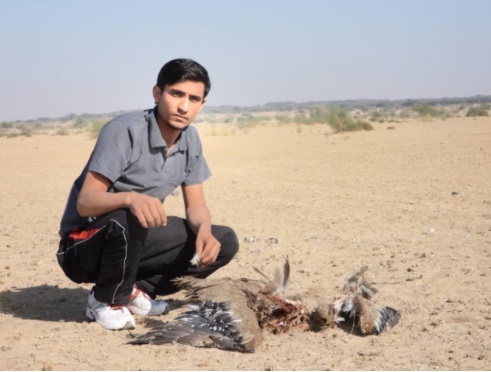Three Gen Z naturalists shared the Sanctuary Wildlife Service Awards this year along with veteran green heroes, whose lives are dedicated to the protection of the biosphere. They come from varying geographies and backgrounds, but their work is directed at saving wildlife, and human life in the process. They are our hope for a green India and a habitable planet in the future.
3 Gen Z naturalists to follow in India
1. Ayushi Jain
Roles: Researcher, community conservationist and student

Miles away from her home state of Uttar Pradesh, Ayushi Jain is weaving science, conservation and good old-fashioned community outreach to protect a rare and endangered species of turtle, the Cantor’s giant softshell Pelochelys cantorii. Last spotted in 2010 by a fisherman in Kerala, the species was seen again in May 2019 in a deep, isolated pool of a river in Kasaragod district.
Ayushi rushed to the location to add fresh information to her research. Because she worked so closely with the local community, she was able to locate as many as 40 key individuals who collectively served as an “alert network” in her study area. She was supported in her efforts by ZSL EDGE of Existence, National Geographic PhotoArk and MBZ Species Conservation Fund. Over the last 18 months, 14 direct and indirect sightings of the elusive species were received. The network also reported the first-ever nest of this species in India. The eggs were carefully incubated in an artificially created environment to protect them from flooding, and natural predation. Community members and their children from the village pitched in to keep an eye on them. After 90 days of arduous documentation, six hatchlings were released at the same place where the nest was found.
Ayushi Jain’s perseverance and compassionate approach has inspired the local community. She has been able to build a strong and informed collective of fisherfolk, and the women and children of the communities around the Payaswini and Chandragiri rivers in Kerala are now a vital source of protection, not only for the Cantor’s softshell turtle, but also the reptiles’ habitat.
In fact, a local community member (who was initially looking to hunt the turtle for monetary benefits) turned into a major protector and joined her project as a key informant. The Forest Department was equally quick to support her initiatives and she continues to conduct multiple training and awareness workshops focused on the training, identification and rescue of the turtles from by-catches.
A promising young biologist, Ayushi Jain embodies the true spirit of conservation.
2. Ramya Nair
Roles: Researcher, anthropologist, conservationist

At 24, Ramya Nair is challenging exclusionary conservation and has become an integral member of the community of Thanamir Village, Nagaland. Since 2019, under a project managed by the Wildlife Protection Society of India (WPSI) and guided by Dr. Sahil Nijhawan (University College London, Zoological Society of London and Nature Conservation Foundation), Ramya works with the Yimkhiung Naga community to document the biodiversity of their ancestral forests.
She chose to identify and immerse herself in local life, participating in their daily chores. She also set up a small library for children. Additionally, her team conducts extensive surveys and interviews, hikes through steep forest slopes in sub-zero temperatures to deploy over 90 camera traps, with the aim to liaise with the village council and co-develop sensitive, rights-based conservation strategies. The camera-trapping exercise eventually led to the documentation of over 23 mammals including, high-altitude clouded leopards, Asiatic golden cats, marbled cat, leopard cats, Indian muntjac deer, red serow, spotted linsang, and more. The team has thus far documented over 220 bird species, including populations of Nagaland’s state bird- the Blyth’s Tragopan, and the count is expected to rise.
Navigating the vagaries of a new and unpredictable borderland is a challenge, but Ramya’s grace, humour and humility have won her the respect and acceptance of her hosts. In a relatively short while, she is learning three local languages and dialects – Chirr-Yimkhiung, Langa-Yimkhiung and Nagamese — a skill that has helped establish trust and reciprocity. Her work has now laid the foundation for equitable, ethical and locally-relevant conservation solutions.
Prior to her work in Thanamir, Ramya led a research project affiliated with the Wildlife Conservation Society-India (WCS-India), under the guidance of Dr. Vidya Athreya, to explore human-big cat relations among the Indigenous Warli community in Maharashtra. Her team documented 150 Waghoba shrines, a big cat deity worshipped by the Warli, and explored how traditional institutions aid shared spaces with big cats. Ramya wove these experiences together into a delightful children’s book, How the leopard became Waghoba.
Currently, even as she engages with the Thanamir student union and village council on collaborative research and conservation in the region, two neighbouring villages have approached her team to expand such work into their ancestral forests – a testament to the goodwill she has generated.
Ramya Nair is a promising young conservation leader, deeply-rooted in the ethics of balancing wildlife, communities and ecosystems.
3. Radheshyam Pemani Bishnoi
Roles: Wildlife conservationist, animal rescuer and photographer


